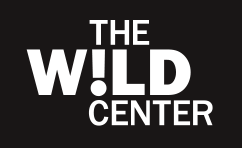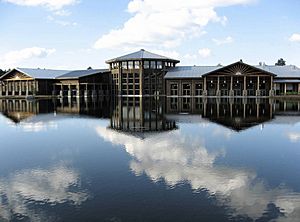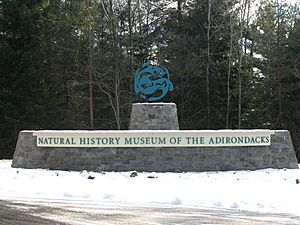The Wild Center facts for kids
 |
|

The Wild Center viewed from Rainbow Bridge
|
|
| Former name | Natural History Museum of the Adirondacks |
|---|---|
| Established | 2006 |
| Location | Tupper Lake, New York |
| Type | Science museum |
The Wild Center is an exciting nature center located in Tupper Lake, New York. It's found right in the heart of New York state's amazing Adirondack Park. This center helps visitors learn all about the natural world of the Adirondacks. It used to be known as the Natural History Museum of the Adirondacks.
Contents
Explore the Wild: Exhibits and Animals
The Wild Center offers a mix of indoor and outdoor adventures. It sits on a huge 115-acre campus with many trails to explore.
Wild Walk: A Treetop Adventure
In 2015, the center opened its famous Wild Walk. This is a special path made of bridges and platforms. It stretches for a thousand feet and rises high above the forest floor. You can walk among the treetops and even over them! It's a unique way to see the forest from a new perspective.
Indoor Discoveries: Live Animals and More
Inside the center, there are five main areas to explore.
The Pataki Hall of the Adirondacks
This hall features the Living River Trail. This trail winds around the hall and has many live animal exhibits. You can see a waterfall and even the center's playful live otters here. The center is home to about 50 different kinds of live animals. Many of them live in special habitats in this hall.
The Big Wolf Great Hall
This large hall has a cozy lean-to, which is a simple shelter. It also features a cool glacial ice wall. This is where the center holds its live animal encounters. You can get up close and learn about some of the animals.
The Naturalist Cabinet
This area is full of hands-on exhibits. You can touch and explore different collections. It's a great place for interactive learning.
Flammer Panoramas Theater
In this theater, you can watch interesting films. These movies explore the Adirondack region and share exciting reports from scientists. They research everything from moose to loons and even alpine mountain tops.
Planet Adirondacks
This exhibit uses a special system called Science on a Sphere from NOAA. It shows how the Adirondacks connect to the rest of the Earth. You can see how everything in nature is linked together.
Meet the Animals
The Wild Center has many live animals. You can see river otters, different kinds of birds, amphibians, and fish. Inside, a marsh seems to flow into a real pond outside the building. You can hear the calls of live owls and otters. The splashing sound of a trout-filled indoor stream adds to the natural feel.
Outdoor Adventures
The center also has outdoor exhibits. These take you right into the natural areas around the center. You can go on canoe trips on the river that flows through the campus. Daily guided trail walks are also offered. In the winter, you can even use snowshoes provided by the center for these walks.
Awards and Green Design
The Wild Center has received important recognition.
National Medal Finalist
In 2015, the center was a finalist for the National Medal for Museum and Library Service. This is the highest honor a museum can receive in the United States. It celebrates museums that do great work for their communities.
LEED Certified Building
The Wild Center was the first museum in New York to be LEED certified. LEED stands for Leadership in Energy and Environmental Design. It means the building was designed and built in a way that is good for the environment. The center earned a silver LEED award from the U.S. Green Building Council. There is even an exhibit at the center that explains all the eco-friendly features of its building.
Community Programs
The center is involved in many projects in the Adirondacks.
Maple Sugar Operation
It helps support a community maple sugar operation. This teaches people about making maple syrup.
Youth Summit
The center also hosts an annual youth summit. This event brings together college and high school students. They research how climate change affects the area. Then, they create plans to help their schools and communities. The center has worked with other science centers on this project, including the Association of Science and Technology Centers (ASTC) and Heureka Science Center in Finland.
Building Design
The main building and its exhibits were designed by The Office of Charles P. Reay with Fish Partners. The St. Louis architectural firm HOK also helped. The Bio Building was designed by Phinney Design Group from Saratoga Springs. The Wild Center first opened its doors on July 4, 2006.
See also



